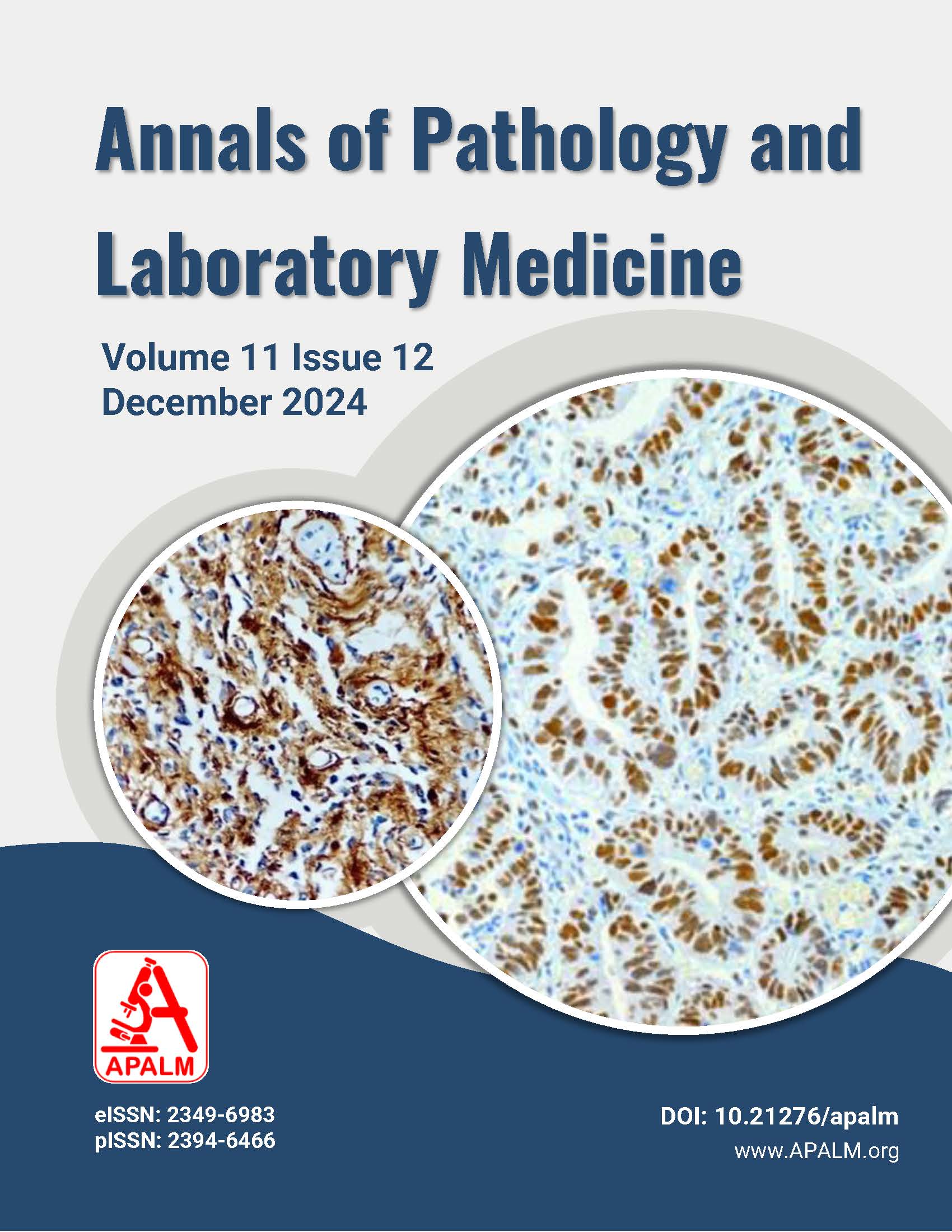Evaluation of Lymph Node Fine Needle Aspiration Cytology in Pediatric Age Group
DOI:
https://doi.org/10.21276/apalm.3376Keywords:
Fine Needle Aspiration Cytology, Paediatric, Lymphadenopathy, ReactiveAbstract
Background: Lymphadenopathy is a common clinical presentation in paediatric practice and may result from diverse disease processes. Fine Needle Aspiration Cytology (FNAC) has proven to be a rapid, minimally invasive, and reliable diagnostic tool with low morbidity. The aim of this study is to determine the utility of FNAC in diagnosing the cause of lymphadenopathy, to identify the spectrum of cytological findings in paediatric lymph nodes, and to correlate cytological findings with clinical, histopathological, and Acid-Fast Bacilli (AFB) staining results.
Materials and Methods: This retrospective study was conducted from January 2011 to December 2013 and included 293 cases of paediatric lymph nodes in the age range of 0-12 years.
Results: A total of 293 lymph nodes were aspirated. The cases were classified as: Benign 277 (94.54%): Reactive 183 (62.46%) [Reactive 166 (56.66%), Florid reactive 17 (5.80%)], Tuberculous lymphadenitis 86 (29.36%), BCG lymphadenitis 3 (1.02%), Non-specific lymphadenitis 4 (1.36%) [Resolving inflammation 3 (1.02%), Suppurative 1 (0.34%)], Dermatopathic 1 (0.34%). Malignant 16 (5.46%): Hodgkin lymphoma (HL) 8 (2.73%), Non-Hodgkin lymphoma (NHL) 7 (2.39%), Metastasis 1 (0.34%), The distribution of cases according to gender, anatomic location of lymph nodes, associated organomegaly, and clinical presentation was also analyzed. Out of the 26 cases with histopathological follow-up, results were concordant in 12 benign and 11 malignant lesions, while discordant in two benign and one malignant lesion.
Conclusion: The calculated sensitivity, specificity, positive predictive value, negative predictive value, and accuracy of FNAC were high for malignant lesions in paediatric lymphadenopathies.
References
1. Lee DH, Baek HJ, Kook H, Yoon TM, Lee JK, Lim SC. Clinical value of fine needle aspiration cytology in pediatric cervical lymphadenopathy patients under 12-years-of-age. Int J Pediatr Otorhinolaryngol. 2014;78(1):79-81.
2. van de Schoot L, Aronson DC, Behrendt H, Bras J. The role of fine-needle aspiration cytology in children with persistent or suspicious lymphadenopathy. J Pediatr Surg. 2001;36(1):7-11.
3. Pambuccian SE, Bardales RH. Lymph Node Cytopathology. In: Rosenthal DL, editor. New York: Springer; 2011.
4. Khan RA, Wahab S, Chana RS, Naseem S, Siddique S. Children with significant cervical lymphadenopathy: clinicopathological analysis and role of fine-needle aspiration in Indian setup. J Pediatr (Rio J). 2008;84(5):449-54.
5. Handa U, Mohan H, Bal A. Role of fine needle aspiration cytology in evaluation of paediatric lymphadenopathy. Cytopathology. 2003;14(2):66-9.
6. Dhingra V, Misra V, Mishra R, Bhatia R, Singhal M. Fine Needle Aspiration Cytology (FNAC) as a diagnostic tool in pediatric lymphadenopathy. J Clin Diagn Res. 2010;4(3):2452-7.
7. Ahmad S, Akhtar N, Singla S, Srivastva G. FNAC as a diagnostic tool in pediatric patients with lymphadenopathy. Ann Biol Res. 2013;4(4):92-5.
8. Lang S, Kansy B. Cervical lymph node diseases in children. GMS Curr Top Otorhinolaryngol Head Neck Surg. 2014;13:Doc08.
9. Mohseni S, Shojaiefard A, Khorgami Z, Alinejad S, Ghorbani A, Ghafouri A. Peripheral lymphadenopathy: approach and diagnostic tools. Iran J Med Sci. 2014;39(2 Suppl):158-70.
10. Jagadish K, Patwari AK, Sarin SK, Prakash C, Srivastava DK, Anand VK. Hepatic manifestations in typhoid fever. Indian Pediatr. 1994;31(7):807-11.
11. Chandni R, Rajan G, Udayabhaskaran V. Extrapulmonary tuberculosis presenting as fever with massive splenomegaly and pancytopenia. IDCases. 2016;4:20-2.
12. Dhinesh Babu K, Bhaskar M, Chitra T. A comparative study of diagnostic efficacy of fine needle aspiration cytology to open biopsy in cervical lymphadenopathy in a tertiary care hospital, Kanchipuram district, India. Int Surg J. 2018;5(12):3847-51.
13. Ataş E, Kesik V, Fidancı MK, Kısmet E, Köseoğlu V. Evaluation of children with lymphadenopathy. Turk Pediatri Ars. 2014;49(1):30-5.
14. Ioachim HL, Medeiros LJ. Ioachim's Lymph Node Pathology. 4th ed. Philadelphia: Lippincott Williams & Wilkins; 2009.
15. Hutchinson RE, Schexneider KI. Leukocytic Disorders. In: McPherson RA, Pincus MR, editors. Henry’s Clinical Diagnosis and Management by Laboratory Methods. 22nd ed. Philadelphia: Saunders; 2012. p. 601-55.
16. Laishram RS, Banashree Devi RK, Konjengbam R, Tamphasana Devi RK, Sharma LDC. Aspiration cytology for the diagnosis of tuberculous lymphadenopathies: a five-year study. J Indian Acad Clin Med. 2010;11(1):31-5.
17. Gupta V, Bhake A. Reactive lymphoid hyperplasia or tubercular lymphadenitis: can real-time PCR on fine-needle aspirates help physicians in concluding the diagnosis? Acta Cytol. 2018;62(3):1-5.
18. Thakur B, Mehrotra R, Nigam JS. Correlation of various techniques in diagnosis of tuberculous lymphadenitis on fine needle aspiration cytology. Patholog Res Int. 2013;2013:824620.
19. Hemalatha AN. Staging of cytological smears in HIV lymphadenitis and correlation with histopathology. J Evid Based Med Healthc. 2019;6(46):2931-4.
20. Kanakala V, Birch P, Kasaraneni R. Florid reactive lymphoid hyperplasia of terminal ileum. BMJ Case Rep. 2010;2010:bcr12.2008.1343.
21. Lakhey M, Bhatta CP, Mishra S. Diagnosis of tubercular lymphadenopathy by fine needle aspiration cytology, acid-fast staining and Mantoux test. J Nepal Med Assoc. 2009;48(175):230-3.
22. Goraya JS, Virdi VS. Bacille Calmette-Guerin lymphadenitis. Postgrad Med J. 2002;78(920):327-9.
Downloads
Published
Issue
Section
License
Copyright (c) 2024 Archana N Rijhsinghani, Leena P Naik

This work is licensed under a Creative Commons Attribution 4.0 International License.
Authors who publish with this journal agree to the following terms:
- Authors retain copyright and grant the journal right of first publication with the work simultaneously licensed under a Creative Commons Attribution License that allows others to share the work with an acknowledgement of the work's authorship and initial publication in this journal.
- Authors are able to enter into separate, additional contractual arrangements for the non-exclusive distribution of the journal's published version of the work (e.g., post it to an institutional repository or publish it in a book), with an acknowledgement of its initial publication in this journal.
- Authors are permitted and encouraged to post their work online (e.g., in institutional repositories or on their website) prior to and during the submission process, as it can lead to productive exchanges, as well as earlier and greater citation of published work (See The Effect of Open Access at http://opcit.eprints.org/oacitation-biblio.html).










